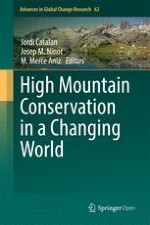Open Access 2017 | Open Access | Book

High Mountain Conservation in a Changing World
Editors: Dr. Jordi Catalan, Josep M Ninot, M. Mercè Aniz
Publisher: Springer International Publishing
Book Series : Advances in Global Change Research
Open Access 2017 | Open Access | Book

Editors: Dr. Jordi Catalan, Josep M Ninot, M. Mercè Aniz
Publisher: Springer International Publishing
Book Series : Advances in Global Change Research
This book provides case studies and general views of the main processes involved in the ecosystem shifts occurring in the high mountains and analyses the implications for nature conservation. Case studies from the Pyrenees are preponderant, with a comprehensive set of mountain ranges surrounded by highly populated lowland areas also being considered.
The introductory and closing chapters will summarise the main challenges that nature conservation may face in mountain areas under the environmental shifting conditions. Further chapters put forward approaches from environmental geography, functional ecology, biogeography, and paleoenvironmental reconstructions. Organisms from microbes to large carnivores, and ecosystems from lakes to forest will be considered.
This interdisciplinary book will appeal to researchers in mountain ecosystems, students and nature professionals.
This book is open access under a CC BY license.